Imfs - Study guides, Class notes & Summaries
Looking for the best study guides, study notes and summaries about Imfs? On this page you'll find 63 study documents about Imfs.
Page 2 out of 63 results
Sort by
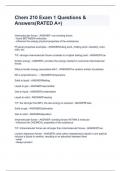
-
Chem 210 Exam 1 Questions & Answers(RATED A+)
- Exam (elaborations) • 10 pages • 2024
-
Available in package deal
-
- $12.49
- + learn more
Intermolecular forces - ANSWER- non bonding forces - found BETWEEN molecules - influence the energy physical properties of the substances Physical properties examples - ANSWERboiling point, melting point, solubility, color, odor, etc. T/F: stronger intermolecular forces correlate to a higher boiling point - ANSWERTrue Kinetic energy - ANSWER- provides the energy needed to overcome intermolecular forces What is kinetic energy associated with? - ANSWERThe random motion of particles...
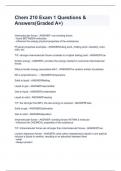
-
Chem 210 Exam 1 Questions & Answers(Graded A+)
- Exam (elaborations) • 10 pages • 2024
-
Available in package deal
-
- $9.99
- + learn more
Chem 210 Exam 1 Questions & Answers(Graded A+) Intermolecular forces - ANSWER- non bonding forces - found BETWEEN molecules - influence the energy physical properties of the substances Physical properties examples - ANSWERboiling point, melting point, solubility, color, odor, etc. T/F: stronger intermolecular forces correlate to a higher boiling point - ANSWERTrue Kinetic energy - ANSWER- provides the energy needed to overcome intermolecular forces What is kinetic energy ass...
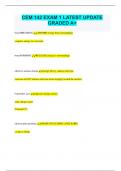
-
CEM 142 EXAM 1 LATEST UPDATE GRADED A+
- Exam (elaborations) • 6 pages • 2024
- Available in package deal
-
- $9.99
- + learn more
CEM 142 EXAM 1 LATEST UPDATE GRADED A+ bond BREAKING ABSORB energy from surroundings -requires energy to overcome bond FORMING RELEASE energy to surroundings effective nuclear charge charge felt by valence electrons -increase in ENC attracts electrons more strongly toward the nucleus Coulomb's Law opposite charges attract -like charges repel F=kq1q2/r^2 electron pair geometry SHAPE INCLUDING LONE PAIRS -count as bonds molecular shape not including lone pairs ...

-
Chem 210 Exam 1 Questions & Answers(Graded A)
- Exam (elaborations) • 10 pages • 2024
- Available in package deal
-
- $19.49
- + learn more
Intermolecular forces - ANSWER- non bonding forces - found BETWEEN molecules - influence the energy physical properties of the substances Physical properties examples - ANSWERboiling point, melting point, solubility, color, odor, etc. T/F: stronger intermolecular forces correlate to a higher boiling point - ANSWERTrue Kinetic energy - ANSWER- provides the energy needed to overcome intermolecular forces What is kinetic energy associated with? - ANSWERThe random motion of particles...
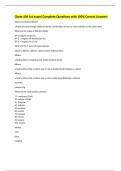
-
Chem 104 1st exam|Complete Questions with 100% Correct Answers
- Exam (elaborations) • 24 pages • 2024
-
- $14.00
- + learn more
Chem 104 1st exam|Complete Questions with 100% Correct Answers What are hybrid orbitals? orbitals of equal energy produced by the combination of two or more orbitals on the same atom What are the types of hybrid orbitals SP- 2 regions of density SP^2- 3 regions of density(3sp^2s) SP^3- 4 regions (4 sp^3s) What are the 4 types of hydrocarbons alkanes, alkenes, alkynes, and aromatic hydrocarbons Alkane a hydrocarbon containing only single covalent bonds Alkene a hydrocarbon that contai...
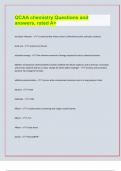
-
QCAA chemistry Questions and answers, rated A+/ 2024/25 exam prediction paper, RATED A+
- Exam (elaborations) • 15 pages • 2024
-
Available in package deal
-
- $9.49
- + learn more
QCAA chemistry Questions and answers, rated A+ acid-base indicator - -a chemical dye whose colour is affected by acidic and basic solutions Acids are - -proton (H+) donors activation energy - -the minimum amount of energy required to start a chemical reaction Addition of potassium dichromate(VI) solution acidified with dilute sulphuric acid to primary, secondary and tertiary alcohols will see a colour change for which (after heating)? - -primary and secondary alcohols. No change for te...
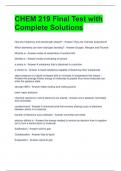
-
CHEM 219 Final Test with Complete Solutions
- Exam (elaborations) • 2 pages • 2024
-
- $11.49
- + learn more
CHEM 219 Final Test with Complete Solutions How are frequency and wavelength related? - Answer-They are inversely proportional Which elements can have hydrogen bonding? - Answer-Oxygen, Nitrogen and Flourine Molarity is - Answer-moles of solute/liters of solution M/L Molality is - Answer-moles of solute/kg of solvent a solute is - Answer-A substance that is dissolved in a solution. a solvent is - Answer-A liquid substance capable of dissolving other substances vapor pressur...
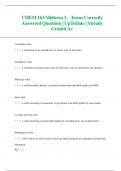
-
CHEM 162 Midterm 2 –Terms Correctly Answered Questions| UpToDate | Already Graded A+
- Exam (elaborations) • 2 pages • 2024
- Available in package deal
-
- $10.09
- + learn more
Crystalline solid : a solid made of an ordered array of atoms, ions, or molecules Amorphous solid : a solid that lacks long-range order for the atoms, ions, or molecules in its structure Molecular solid : a solid formed by neutral, covalently bonded molecules held together by IMFs Ionic solid : a solid consisting of monatomic or polyatomic ions held together by ionic bond
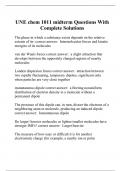
-
UNE chem 1011 midterm Questions With Complete Solutions
- Exam (elaborations) • 10 pages • 2023
-
Available in package deal
-
- $10.49
- + learn more
The phase in which a substance exists depends on the relative extents of its- correct answer: Intermolecular forces and kinetic energies of its molecules van der Waals forces correct answer: a slight attraction that develops between the oppositely charged regions of nearby molecules Londen dispersion forces correct answer: attraction between two rapidly fluctuating, temporary dipoles; significant only when particles are very close together instantaneous dipole correct answer: a flee...
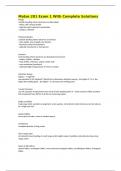
-
Matse 201 Exam 1 With Complete Solution
- Exam (elaborations) • 7 pages • 2024
-
- $10.89
- + learn more
Matse 201 Exam 1 With Complete Solutions Metals metallic bonding where electrons are delocalized - dense, stiff, strong, ductile - high thermal & electrical conductivity - opaque, reflective Polymers/plastics covalent bonding where electrons are shared - soft, ductile, low strength, low density - thermal & electrical insulatiors - optically translucent or transparent Ceramics ionic bonding where electrons are donated and received - oxides, nitrides, carbides - hard, brittle...

Did you know that on average a seller on Stuvia earns $82 per month selling study resources? Hmm, hint, hint. Discover all about earning on Stuvia


